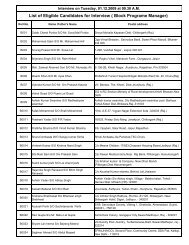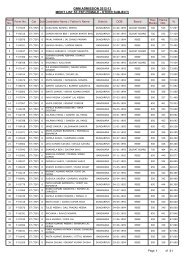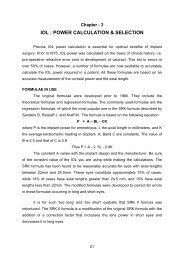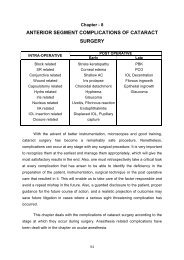THE LENS - APPLIED ANATOMY AND EMBRYOLOGY
THE LENS - APPLIED ANATOMY AND EMBRYOLOGY
THE LENS - APPLIED ANATOMY AND EMBRYOLOGY
Create successful ePaper yourself
Turn your PDF publications into a flip-book with our unique Google optimized e-Paper software.
Iris fixated IOLs were in vogue in the past. However, long term problems<br />
associated with these lenses have decreased their popularity. The highly mobile iris<br />
produced chafing and resultant inflammation. The only iris fixated lens in use today<br />
is the Singh - Worst lens which is fixated near the peripheral iris, which is relatively<br />
immobile. Recently there has been renewed interest in this lens design for use in<br />
phakic IOL implantation for the correction of the refractive errors.<br />
The posterior chamber is bounded anteriorly by the iris and posteriorly by<br />
the anterior hyaloid face of the vitreous. The circumference of the posterior chamber<br />
consists of the ciliary sulcus and the ciliary body. The lens equator is typically<br />
adjacent to the midpoint of the ciliary body. There is a space of 0.2-0.3 mm between<br />
the ciliary body and lens equator. After cataract removal, the capsular bag volume<br />
collapses to essentially zero as the anterior capsule comes into apposition with the<br />
posterior capsule. The equator of the evacuated bag extended laterally, causing the<br />
bag diameter to enlarge from the normal 9.5 mm to approximately 10.5mm. At this<br />
large diameter, the lens equator directly contacts the ciliary body and the normal<br />
psychological space is lost. The equator of the evacuated capsular bag also moves<br />
to a location posterior to the ciliary processes.<br />
When a 12mm PMMA PCIOL is implanted into the capsular bag, the bag<br />
becomes oval, with dimensions of 11.2 mm x 9.2 mm. The optics of almost all<br />
intracapsular IOLs will be positioned at a plane posterior to the ciliary body. One<br />
reason for this is that the angulation of the haptics in most IOLs produces direct<br />
contact of the optic with the posterior capsule and stretching of the posterior capsule.<br />
When the capsular bag is intact, in-the-bag fixation of both haptics is clearly the most<br />
optimal method of IOL fixation. Capsular bag fixation avoids direct contact between<br />
the haptics and uveal tissue and is associated with a lower likelihood of decentration<br />
and central posterior capsule opacification.<br />
The ciliary sulcus, also known as posterior chamber angle, is formed by the<br />
junction of the posterior iris with the ciliary body. The average diameter of the ciliary<br />
sulcus is 11.0mm. The ciliary sulcus is a common location for PCIOL implantation<br />
when the posterior capsule of does not provide sufficient support for the placement<br />
of an intracapsular lens and the anterior capsule is intact. When a continuous<br />
curvilinear capsulorrhexis has been performed and remains intact, the ciliary sulcus<br />
9
















